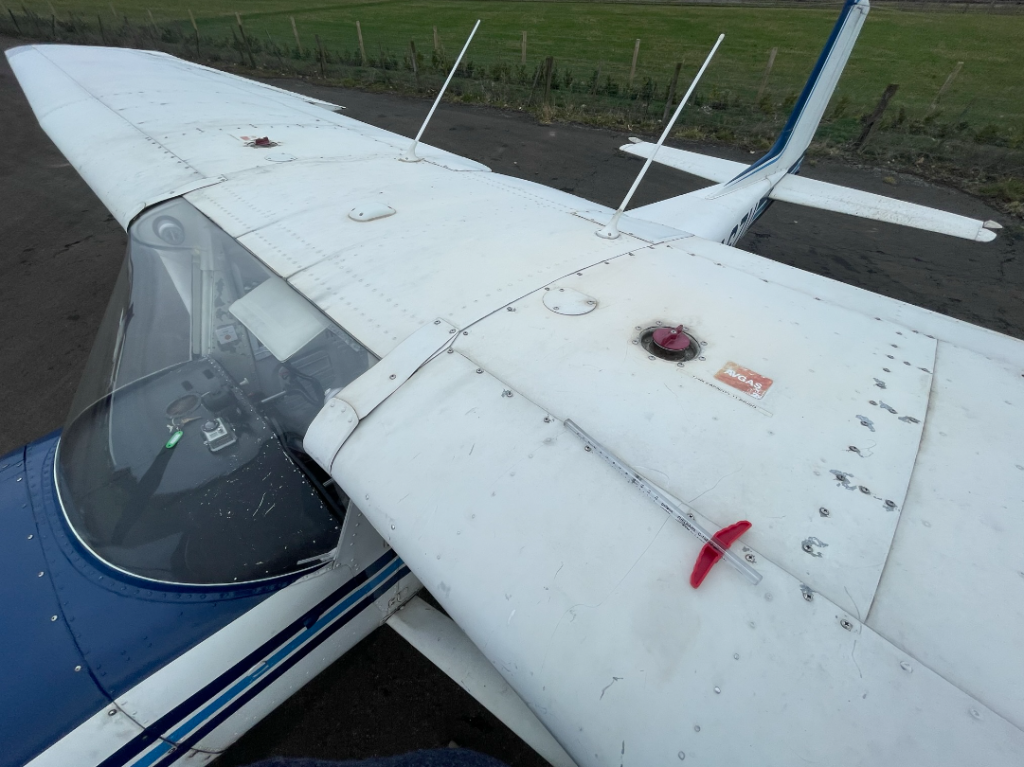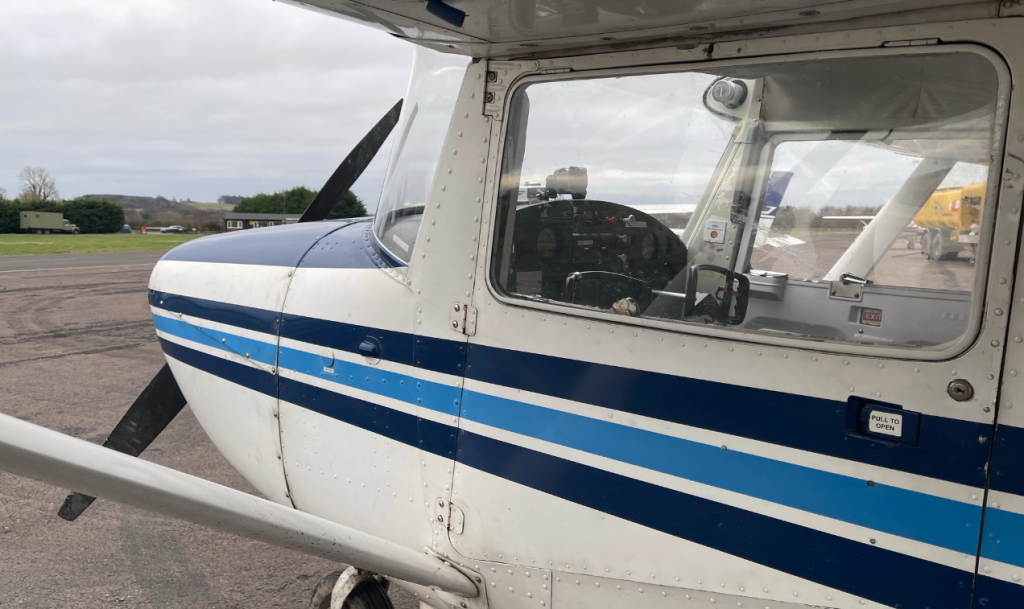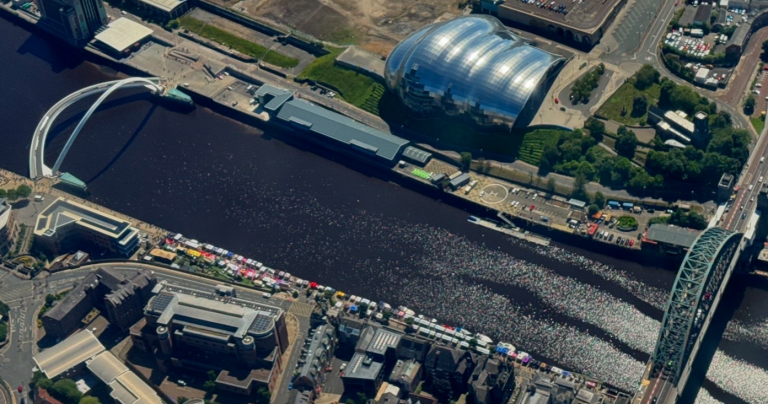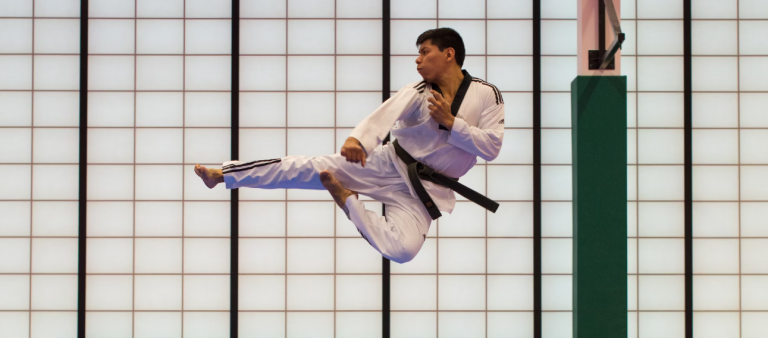An overcast day but that shouldn’t be a problem. Winds quite light but variable. Will I finally get to solo today?
Aside from one intervention to avoid a heavy landing and several demonstrations, the instructor hasn’t touched the controls since my 2nd lesson. Over the last few lessons my instructor has been saying less and less to the point that I find myself cracking jokes just to break the silence.
Of course this is all part of the instruction – he’s been getting me used to doing it all myself so that when the day comes for me to solo, and he steps out the aircraft, it doesn’t feel like a complete shock.
That was our goal today: impress my instructor and wow his boss, the Chief Flight Instructor, and if I could do those, they’d let me take this vintage classic into the air all by myself.
Let’s see how I got on…
Checks
After 2 lessons of circuits and an hour practising in X-Plane 12 last night, I feel like I’m trying to perfect them, rather than still trying to work out the basics.
I brought the GoPro my mate Tim loaned me because I knew that the aircraft I’d booked – ‘UJ’ – had a GoPro mount in it, but on arrival I was told we’d be using the straight-tailed Cessna 150E – ZU. D’oh!
I went out and ran through the external and internal checks.
The external checks begin at the port (left side) undercarriage, we check the leg is undamaged, the hydraulic line is in good condition, the disc brakes aren’t marked or pitted, then we look at the front of the wheel.

Here we are looking for two things: 1, that the bolt holding the wheel on is secure with a locking pin inserted, and 2, that the slip mark (the red paint) is lined up.
If your tyre is able to freely move around the wheel when this becomes a problem when you try to brake…

We drain a little fuel to check there is no water contamination – the aircraft are kept in the hangar overnight so this is unlikely but unlikely is not good enough and we always check. the fuel is coloured slightly blue and any water shows as a clear layer at the top of the drained fuel.
We also do a visual inspection of the fuel in the fuel tanks to make sure the fuel gauges aren’t lying to us. You can see above lying on the leading edge of the wing a special device that you put into the fuel tank and you can read off the fuel quantity. For short-arses like me this requires the walk of shame to get a stepladder.
Circuits the First
Once the aircraft was checked, I got in and so did my instructor, saying very little, and I started her up.
“Eshott radio, Golf-Alpha-Sierra-Zulu-Uniform radio check 122.855, backtracking runway 19 to charlie,” I said over the radio.
“Readability 5,” came the reply.
“Readability 5 also,” I said, letting them know they were also sounding crystal clear.
I accelerated the aircraft gently forward before touching the brakes to ensure they were working – all good! Next I taxiied onto the runway and started to back-track down runway 19.
We made a deliberate choice to use runway 19 even though the wind was coming from approximately 290 degrees, which favoured runway 25. Firstly, 19 (and 01, the same runway but the other direction) is the longer runway at 600m of (unlicensed) length, and 19 also has a bit of disused runway just before the actual runway starts, so if I managed to get to do a solo and did something silly like undershooting the runway, it wouldn’t be as much of a problem.
Halfway down we spotted something on the runway – it was a deer! I pulled the throttle out and the aircraft coasted, we knew deer normally travelled in twos or small families. Soon enough we spotted the mother of the smaller deer (which we’d already named Bambi) which followed her child across the runway.
At holding point Charlie I did the power checks and then made another radio call.
“Golf-Zulu-Uniform, ready for departure, lining up runway 19.”
I taxiied into position and pushed the throttle forward while adding a dab of right-rudder. The wind was from the right so was already helping to keep that yawing motion caused by the propeller in check. It did require a touch of opposite aileron while rolling down the runway to counteract the rolling moment caused by the wind blowing against the large tail fin.
The tail fin is known as a “keel surface”, which, like the keel of a boat, provides longitudinal stability, but it is also a large flat surface that is sensitive to being blown by the wind. On today’s lesson this wind was actually help counter-act the typical yaw from the propeller, but it did mean I’d be landing with a cross-wind.
At 60 knots I lifted ZU into the air, let the wind catch the tail and weather-cock her slightly to point the nose into the wind to avoid drifting off the runway extended centre-line and pitched for a 60 knot Vy climb.
At 300ft I raised the flaps, operating the large hand-brake looking level in between the two seats.
At 450ft I tilted the upwind wing a touch to check there was nothing hiding above it then at 500ft I made a 15 degree “rate 1” turn onto crosswind (actually upwind with the prevailing shifting air!).
At 950ft I started to lower the nose, nailing the 1,000ft pattern height perfectly. Once stable I did another quick wing tilt, nothing there, and made a “rate 2” 30 degree turn onto downwind.
“Golf-Zulu-Uniform, downwind, runway 19.”
I ran through the downwind checks – B. U. M. F. I. L. C. H. – All good and maintained 1,000ft QFE all the way.
When we were alongside (“abeam”) the “19” numbers on the runway I’d just took off from and would shortly be trying to land on I started to configure for landing. Carb heat, power to 1500rpm, flaps to 20 degrees, wait for 60 knots, pitch to hold 60 knots and trim to keep her happy descending at 60 knots.
At 800ft above the runway elevation I turned onto the base leg, checking for any no-radio (NORDO) traffic that might be joining straight in – that is any traffic that doesn’t do an overhead join and instead flies straight onto final approach. Nothing was in sight. The pattern and the airspace around it was very quiet.
At 500ft I turned onto final approach. “Golf-Zulu-Uniform final runway 19,” I said, clipping the end of the word ‘nine’ as we got hit by a gust of wind that sent us off to the left of the runway centreline.
I corrected and brought the aircraft down a stable approach path to the runway. At 50ft I closed the throttle, and plonked the 150 down on the centreline. It was harder than my ‘average’ landing but not too bad.
I pushed the throttle open fully and closed the carb heat in a quick one-two motion, keeping the aircraft more or less straight.
As the air speed was passing 60 knots I started to pull the nose up, using the rudder pedals to control the weather cocking from the wind.
“My throttle,” said the instructor. Same game as last lesson then……..
At 100ft I raised the flaps from 20 degrees to 10 degrees and at 300ft I raised the flaps completely, maintaining a 60 knot climb.
At around 400ft the engine died.
Or at least, it felt like it, the instructor had pulled the throttle closed and we began to haemorrhage air speed. I pushed the nose forward positively and found 60 knots on the ASI.
“That field there,” I pointed to a field straight ahead. But we were a little high. I extended the flaps, straight to 20 degrees, and we started to make a more controlled descent towards the grassy field looming large in our windscreen.
At 200ft with the field easily made the instructor said, “your throttle.”
I pushed the throttles forward while lifting the nose and pushing on the right rudder pedal. With 20 degrees of flaps we didn’t climb very quickly but once we were showing a positive rate on the VSI I brought one notch of flaps up, then again at 300ft to give me a clean wing.
At 500ft I turned right onto crosswind, then at 1,000ft onto downwind. I made the downwind radio call and ran through the pre-landing checks. I configured for landing and descended at 60 knots, turned onto base leg, checked for traffic.
It was all becoming a bit routine.
Then when I turned onto final approach a gust of wind hit us hard. I couldn’t get the nose to turn without buckets of rudder pedal and we overshot the extended centreline of the runway. Eventually I got us lined back up again but we were 10 knots fast and a bit high so I had to pretty much close the throttle to lose height and held the nose up to bleed the speed off. Despite how the approach started – chaotically – by the time we were at 50ft when I’d normally close the throttles for the flare we were bang-on the approach profile. All I had to do was lift the nose to enter ground effect and then progressively pull back as the aircraft started to sink with less and less lift from the wings.
The wheels gently touched down – it was a great landing by any measure – and we rolled to the end of the runway where the Chief Flying Instructor was waiting for us.
Circuits the Second
I swapped my instructor for the Chief FI and I ran through the after-landing checklist, followed by the after-start checklists. I was determined to impress him. Then I made my first cock up of the day.
“Eshott Radio, Golf-Alpha-Sierra-Zulu-Uniform radio check 122.855……” then I got confused.
“Readability 5,” replied my instructor, now perched at the radio inside the warm clubhouse.
“Golf-Zulu-Uniform ready for departure lining up…. correction….”
My brain was confused – I was at a holding point next to runway 01 and the wind was currently favouring runway 01 coming very gently from the north….. but we’d already agreed to use 19, the opposite end of the runway I was stopped at.
It was nerves. I took a deep breath to clear my head. “Correction, backtracking runway 19 to Charlie.”
I turned the aircraft so I could see the approach path for runway 01 in case any NORDO aircraft had joined overhead and chosen (as my brain just had) to use that runway, and seeing it was clear I taxiied the aircraft all 600m to the other end of the runway.
At Charlie I ran through the power checks and the pre-take off checklist, trying to demonstrate competence to the Chief FI.
“Golf-Zulu-Uniform ready for departure, lining up runway 19.”

I taxiied to the threshold of runway 19 and once the nosewheel was straight I pushed the throttle full forward, adding a touch of right aileron to counteract the crosswind that the wind sock had started to indicate.
“Airspeed alive, Ts & Ps in the green, RPM stable,” I said, as the aircraft drifted right of the centreline.
At 60 knots I lifted the nose off the runway and corrected for a sudden gust of wind. It wasn’t pretty but it was safe.
I climbed out at 60 knots, making sure not to make my usual mistake of allowing the speed to increase. At 300ft I raised the flaps and raised the nose to keep 60 knots on the Air Speed Indicator (ASI). At 450ft, where I’d normally turn I made a comment that I’d extend the upwind leg to avoid any noise complaints from the golf club we’d overfly.
“They make enough noise shouting Fore! all the time,” said the Chief FI, breaking the tension.
At 950ft on crosswind I gently lowered the nose and caught 1,000ft QFE exactly. I reduced power to cruise power and trimmed to maintain the attitude before turning onto downwind.
“Golf-Zulu-Uniform, downwind runway 19.”
A ran through half of the BUMFILCH checks before the Chief FI interrupted me.
“We’ll do a touch and go this time,” he said.
I knew this was to put me off and see if I could continue the memory items. I saved where I was up to in a braincell somewhere in my grey matter, acknowledged that it would be a touch and go, then dived straight back into the checks from where I left off.
“Carb heat…. will leave it on at this point as we’re about to configure.”
“Sensible,” he said.
Abeam the runway numbers I configured, dropped the flaps and descended. At 800ft I turned onto base leg explaining that I was going to keep the River Coquet on our right, and then turned onto final slightly overshooting the centreline. I corrected but the wind had picked up meaning I had to crab all the way down to the runway.
We landed with a bump but on the centreline, I pushed the throttle forward immediately followed by closing the carb heat.
“Nice,” the Chief FI said.
During a touch and go the 150 isn’t trimmed right. Going from a low power glide to full power, the nose is very eager to climb, and the tyres will often ‘skip’ early, as they did here. The wind caught us and we started to slide sideways. We were already at 60 knots so I lifted the nose and decided to sort it out as we climbed. I pushed down on the right rudder pedal to get us back onto the centre line of the runway and dialled in 60 knots on the ASI.
I expected at any moment for the Chief FI to take control of the throttle and simulate an EFATO (engine-failure-after-take-off) but after I’d gone through 400ft and was looking to turn onto crosswind I assumed that wasn’t going to happen.
Climbing to 1,000ft, turning onto downwind, doing the radio call for downwind, BUMFILCH and configuring for landing all happened very quickly.
“This will be a go around, if you don’t mess up the landing, I will,” said the Chief FI with a mischievous chuckle.
Annoyingly this approach was reminiscent of one I distinctly remember from my 4th lesson where the aircraft was so in-trim it felt like we were going down a set of rails towards the runway.
I closed the throttle and started to round out, wondering what the Chief FI was going to do to make us go around, because I certainly hadn’t messed up the landing. So far….
As we entered ground effect the mischievous man sat next to me grabbed the controls and jerked them back. “Gust of wind,” he smiled.
I firewalled the throttle whilst progressively pushing down the right rudder pedal and raising the nose. “Going around.” I kept the clubhouse in the Lindbergh window as a reference to stay on the runway centreline.
“That was good,” said the Chief FI.
As we climbed out and I raised the flaps, I was sure he was going to hit me with the EFATO this time but it still didn’t come and before I knew it we were back on final. This time the wind was gustier and I didn’t dial it in as well as the previous landing. The tyres touched down shortly after the numbers and we rolled down to holding point Charlie where I’d picked up the Chief FI earlier for the verdict.

One More Circuit
As I parked up, the Chief Flight Instructor said, “Make sure you do the after landing and before take off checks.”
And then he started gathering up his belongings.
“Nice flying,” he said, shook my hand and then stepped out, striding over towards the clubhouse.
And then I was sat in a running aircraft all by myself.
I expected it to be terrifying, or really weird at least. It was neither. In the previous three lessons I’d done nearly two dozen circuits with only minimal pointers from my instructor. We had drilled every scenario. I knew exactly what I needed to do and I felt prepared to do it.
I ran through the after landing checklist, closing the carb heat and raising the flaps. “Golf-Zulu-Uniform backtracking runway 19 to Charlie.”
For the 3rd time this lesson I turned to check the approach to runway 01, saw nothing, and started to taxi down the runway. Earlier we saw deer crossing so I was vigilant to check for them or any other wildlife roaming the airfield. They were staying scarce.
I pulled into holding point Charlie, ran the power checks and stepped through the before take off checklist. Without a second person shoe-horned into the tiny space inside the C150 it was a lot easier to check all the gauges and indications. I felt pretty calm. After almost an hour of trying to impress it felt like the pressure was now off and I just needed to do what I’d been trained to do.
With the before take off checklist complete, I made another radio call, “Golf-Zulu-Uniform, ready for departure, lining up runway 19”.
I lined up, took a breath, and pushed the throttle forward while adding the smallest dabs of right-rudder as the wind was coming quite steadily from the right now. I added some right-aileron too to counteract the wind on the tall tail fin.
I methodically checked the temps and pressures, RPM stability and the air speed. And then I was in the air, raising the flaps, turning onto crosswind, levelling off at 1,000ft, and turning onto downwind. It felt like that all took about 8 milliseconds.
“Golf-Zulu-Uniform, downwind runway 19,” I said, surprised how calm my voice sounded.
I ran through the downwind BUMFILCH checks and while I waited to come abeam of the runway numbers I had a moment of pause to appreciate what was happening.
I glanced around the little aircraft almost to prove to myself that I was the only one there. Outside each window was a mind-blowingly beautiful vista of Northumberland – the Cheviots to the left, Amble Harbour and the North sea to the right, historic Alnwick to the north, beautiful. It was really nice just to enjoy that moment.
Then the runway numbers slid alongside the little Cessna and I got back to work, configuring for landing. Carb heat, 1500rpm, 20 degrees of flaps, 60 knots, trimmed out, turned onto base, looking out for any straight-in joiners. It was still clear. I turned onto final at 500ft, adding a little power as the runway was starting to move up in the window.
On final I pushed the transmit button attached to the control yoke, “Golf-Zulu-Uniform, final runway 19.”
I had to crab the little Cessna into the wind but I somehow managed to find a good angle that brought me nicely toward the runway on the centreline. At 100ft I was a bit fast so I reduced power and raised the nose, this destabilised the approach a little and I prepared to go around.
After the Chief FI had interrupted my landing with his fictional gust of wind and we were climbing out I joked, “that was going to be a good landing!” He laughed and replied, “always assume you’re going around, it’s a bonus if you land.”
That buzzed around my head as I continued towards the runway.
I had kept on the centre line, the only thing that was slightly off was the speed was coming down a bit quickly. I added a dab of power, getting ready to push it all the way to the firewall if I decided to go around.
That dab arrested the speed at 60 knots, just at the point I would reduce the power to idle to flare and land, so I did just that.
I had to do a little bit of a tap dance on the rudder pedals to keep straight with the different power settings causing the tail to yaw, but it was under control as I crossed the threshold of runway 19. Once over the runway the wind lessened and I straightened the nose down the runway, first flying level at about 5 feet off the ground, then holding the nose up as I sank with less and less speed and less and less lift.
I really wanted to grease this one but the wheels dropped to the runway a little harder than I’d hoped. Not great, not terrible.
I let the Cessna roll down the runway slowing itself down through friction alone.
“Golf-Zulu-Uniform,” it was my instructor over the radio, “congratulations on your first solo! Please park up where you found it. Make a note of the Hobbs meter.”
“Thank you, wilco.” I replied.
I slowed ZU down, and stopped her where she had been waiting for me earlier that morning. I ran through the after landing checklist, raising the flaps, setting the carb heat to cold, and then ran through the shut down checklist, ensuring the magnetos and everything was still working.
All good, I shut down the engine and electrical systems, taking a quick photo of the Hobbs meter (which basically dictates what you get charged!!).
As I walked back to the clubhouse with more than a bit of a spring in my step my instructor came out and marched me back to the aircraft for a photo op which I happily obliged.
And that was my first solo.




